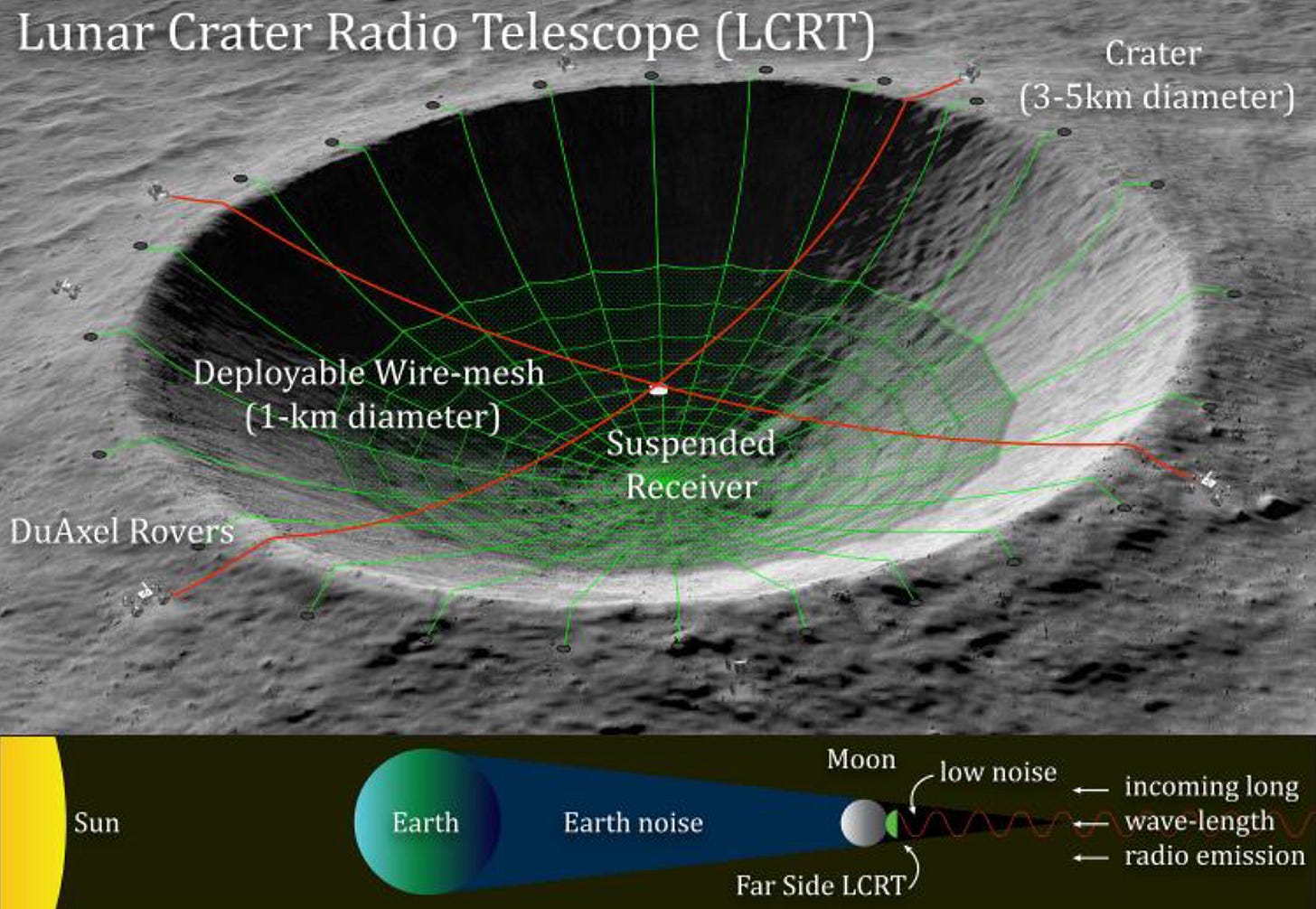Space Talks: A Telescope in Lunar Crater
Interview with JPL's Robotics Technologist Saptarshi Bandyopadhyay who recently won a NIAC grant for Lunar Crater Radio Telescope.
The worlds in popular stories such as The Martian, Space Odyssey, Seveneves present humanity having stations on the Moon and Mars. NASA's current Artemis mission is a step towards making permanent human settlements on these planetary bodies. While many scientists and engineers are working on these 'missions' to make science fiction a reality, there are a few researchers considering new 'concepts'. The US Space Agency recently gave out NASA Innovative Advanced Concepts (NIAC) grants to some of these research teams. The list includes Plasma Rockets for Martian Missions, Deceleration of Spacecraft using Antimatter, Enceladus Vent Explorer, Lunar Polar Mining Outpost and many more. Amongst them is the Lunar Crater Radio Telescope (LCRT) on the Far-Side of the Moon. The LCRT concept has been proposed by the team of Saptarshi Bandyopadhyay.
Saptarshi is a Robotics Technologist at the NASA Jet Propulsion Laboratory, California Institute of Technology. As an undergraduate, he co-founded and led IIT Bombay's Student Satellite Project which launched satellite Pratham on 26th September 2016—enabling me to have the opportunity to follow in his footsteps by leading the team in the last two years. He recently travelled to India in February and received the news of the grant while being in lockdown at his home in Mumbai. I asked him a few questions in regards to his concept of the Lunar Crater Radio Telescope.
What is the Lunar Crater Radio Telescope (LCRT) concept that you propose? How is it different from the Telescopes on Earth?
It is not possible to observe the Universe at wavelengths higher than 10m (i.e., frequencies below 30MHz) from Earth-based stations because the Earth's ionosphere reflects these signals. Moreover, Earth-orbiting satellites would pick up significant noise from Earth's ionosphere. Hence such observations are challenging.
Therefore, the wavelengths higher than 10m (i.e., frequencies below 30MHz) are hitherto mostly unexplored by humans till date.
The Moon acts as a physical shield that isolates the lunar-surface telescope from radio interferences/noises from Earth-based sources, ionosphere, Earth-orbiting satellites, and Sun's radio-noise during the lunar night. Hence a telescope on the far side of the Moon can observe the wavelengths higher than 10m (i.e., frequencies below 30MHz).
Quoted Saptarshi
When did you think of this concept? How long have you been working on this?
We have been working on this for three years now.
Quoted Saptarshi
In these three years, the team has developed a unique concept to establish this 1 km diameter telescope. A set of wall climbing DuAxel robots will deploy the required 1 km diameter mesh in a 3-5 km wide lunar crater. This Lunar Crater Radio Telescope will be the largest filled-aperture radio telescope in the Solar System! Currently, a Five-hundred metre Aperture Spherical Telescope or FAST is the largest one on Earth.
Now, with the NIAC phase 1 fellowship, what will be the further timeline?
I want to emphasize that LCRT is in very early stages of development. It is not currently a NASA mission.
The objective of NIAC Phase 1 is to study the feasibility of the LCRT concept. During Phase 1, we will mostly be focusing on the mechanical design of LCRT, search of suitable craters on Moon, and comparing the performance of LCRT against other ideas that have been proposed in the literature.
We will see what's ahead after finishing Phase 1.
Quoted Saptarshi
Do you have any predictions you have regarding what we may observe from Moon's farside?
I have written a paper on a previous-version of the LCRT concept, which available at https://ieeexplore.ieee.org/document/8396801
Quoted Saptarshi
While he quoted the science goals of LCRT from that paper: First Stars and the "Cosmic Dawn". In simpler terms, the team envisions finding out new and exciting information about the formation and evolution of the Universe by observing a unique spectral feature of neutral hydrogen which was one of the dominant components of the early intergalactic medium.
Saptarshi Bandyopadhyay is a Robotics Technologist at the NASA Jet Propulsion Laboratory, California Institute of Technology, where he develops novel algorithms for future multi-agent and swarm missions. He received his PhD in Aerospace Engineering in 2016 from the University of Illinois at Urbana-Champaign, USA, where he specialized in probabilistic swarm guidance and distributed estimation. He earned his Bachelors and Masters degree in Aerospace Engineering in 2010 from the Indian Institute of Technology Bombay, India, where, as an undergraduate, he co-founded and led the institute's student satellite project Pratham, which was launched into low Earth orbit in September 2016. His engineering expertise stems from a long-standing interest in the science underlying space missions, since winning the gold medal for India at the 9th International Astronomy Olympiad held in Ukraine in 2004. Saptarshi's current research interests include robotics, multi-agent systems and swarms, dynamics and controls, estimation theory, probability theory, and systems engineering. He has published more than 40 papers in journals and refereed conferences.



